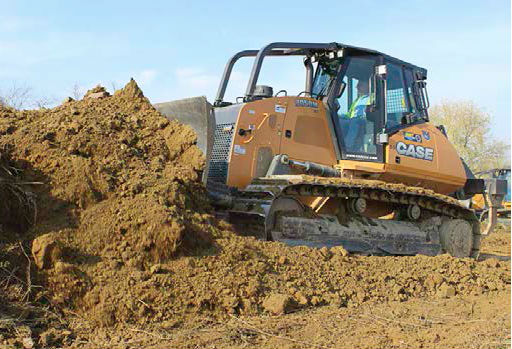March 2015, Vol. 242, No. 3
TechNotes
Boom Increases Contractors Earth-Moving Business

With a name like Steele in Pennsylvania, you’d expect Steele Construction, Inc. owner Bill Steele to specialize in structural steel building or own a foundry. Instead, he’s one of the premier builders of timber-framed homes in the state.
As things changed and housing starts dipped during the recession beginning in 2007, Steele expanded his business on the strength of the Marcellus Shale natural gas boom.
“We were lucky enough to get into a gas contract, and now our company is pretty much evenly split between the building of heavy timber frame and moving dirt,” said Steele.
The company now specializes in site reclamation at new gas extraction sites. When a well pad is finished, it may only take up an acre of space, but the surrounding area must be returned to its natural state. A recent job in Derry, PA included moving and final grading about 50,000 cubic feet of dirt, closing in a retention pond built for pad construction and returning about 4 acres back into farmland.
“Time is money and the gas companies want the reclaiming done within a tight timeline,” Steele said. “The only way we could do it was with bigger equipment.”
To that end, he added four new dozers to his fleet in 2014: two 850L dozers and two 2050M dozers from CASE Construction Equipment. The biggest change came with the size of the two 2050Ms (214 hp, 45,414 pounds).
“We went from very small to very big. It was a big step for us but it was the best step we ever did,” Steele said. “We get on and off the jobs faster and we are actually making more money with the bigger dozers.”
Right-Sizing The Fleet
The 850Ls fit the mold of the dozers previously owned by Steele. These relatively smaller machines are excellent support dozers used for everything from site cleanup and final grading to pulling a compacting roller around the site. The lower weight and smaller footprint make them easy to transport and easy to maneuver.
To meet the larger earthmoving demands of well site reclamation, Steele expanded to the considerably larger 214 net hp 2050M. Outfitted with a 6.3-cubic-yard blade and featuring 81,000 pounds of drawbar pull, the 2050M was a major increase in the company’s earthmoving power without making it too difficult to transport the machine from site to site.
“The roads up there are very narrow, bridges are small. It just happens this is the largest dozer we can get into some of these pads,” said Steele. “We still need two permits on this dozer, but we at least can get them across the bridges.”
The 2050M is equipped with Tier 4 Interim selective catalytic reduction (SCR) engine technology. CASE M Series dozers are the only dozers in the industry to use SCR, and the technology is well-suited to the task: dozers rely on brute force and raw power to move material.
SCR lets the engine breathe more freely and run at peak performance without compromising the power or drawbar pull required to move material when it’s needed most. Simply put: all of the engine’s useful effort is put toward the power needed to move dirt. The 2050M provides a 14% increase in power and a 10.5% increase in fuel savings over CASE’s previously largest dozer, the 1850K.
“I notice that whenever it gets a full blade it doesn’t bog down. It just keeps pushing the dirt,” said Jack Snyder, dozer operator for Steele Construction. The optional ripper equipped on one of his 2050Ms turned out to be a nice surprise for Steele as well.
“The ripper was a little different than I was expecting but it turns out that it is exactly what we need,” he said. “We do a lot of ripping of roads, and the ripper saves us a lot of time. Once we rip the road or the parking pads up, almost any dozer can push the stone off, it’s like pushing loose stone.”
The machine also works well on varied terrain. When reclaiming ponds and other portions of well sites, the dozers occasionally work on steep slopes. The 2050M proved to be stable and able to retain its power, even in sloped conditions.
Empowering Operators
The controls and interiors of the new dozers have been redesigned over previous models. The 2050M features adjustable steering and shuttle ratio settings (smooth, moderate or aggressive) to help the operator match machine performance to ground conditions. Several blade functions are easily manipulated by fingertip controls, including blade angle, blade sensitivity and blade shake.
“Actually from the beginning, the dozers are a lot less complicated to run right now. These dozers will turn on a dime. The blades are quick to react to your touch. The wobble sticks are fantastic”, said Steele.
The 2050M features a cab-forward design, floor-to-ceiling glass doors and a sloped hood that provides excellent visibility to the blade and ground. The visibility of the machine continues to stand out to the operators. The positive-pressure/sealed cab has been redesigned to keep the operators comfortable – a request made specifically by the companies hiring Steele.
“The gas company requested us to go to closed dozers,” said Steele. “We have noticed the guys seem to be much more comfortable. They work longer and don’t mind it. The cabs keep the noise down.”





Comments